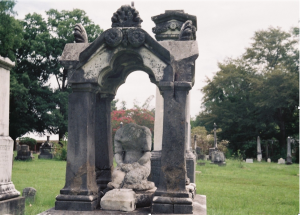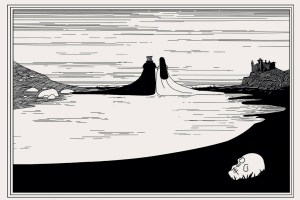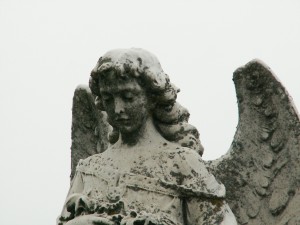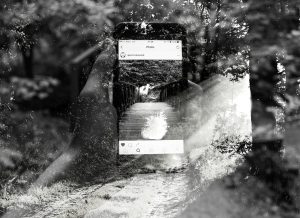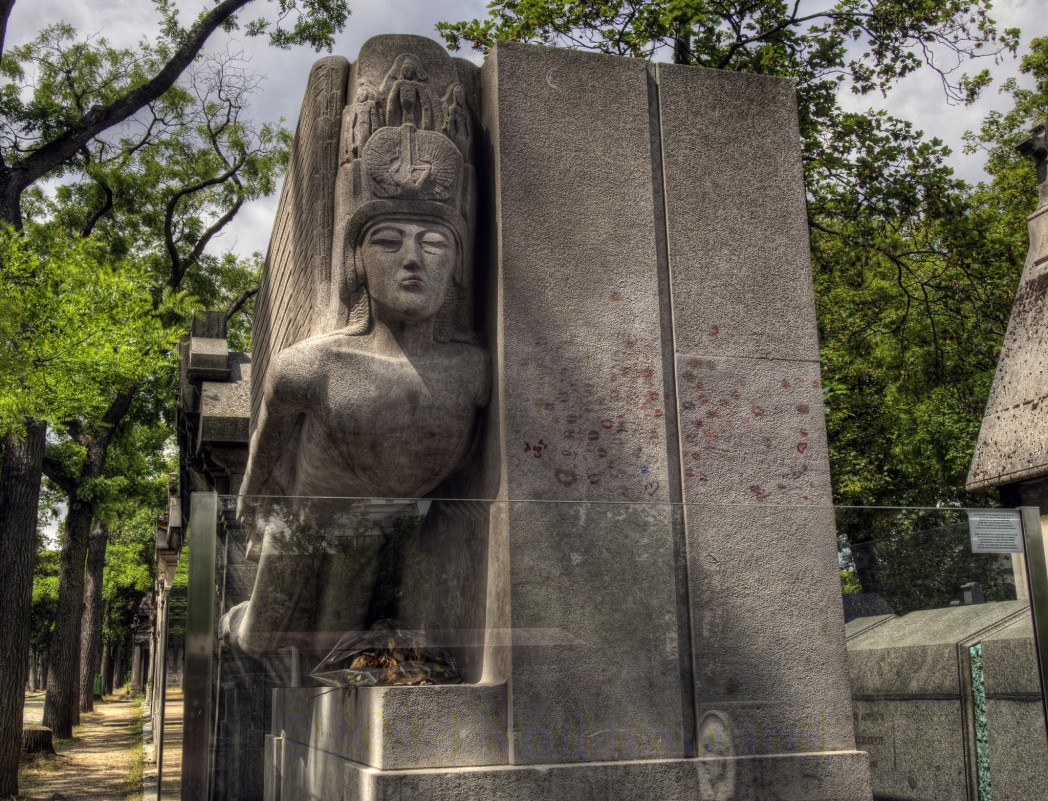
Literary Graves
by Francis Martin | May 29, 2015
“You know what was written on Keats’ grave? ‘Here lies one whose fame was writ in water.’” Bob Dylan mulls this over. “Where’s he buried?” Dylan is with Allen Ginsberg, visiting Jack Kerouac’s grave in Massachusetts. Ginsberg asks what graves the singer has seen. A pause. “Victor Hugo’s grave.” Ginsberg replies: “I used to haunt graveyards in Paris.”
Visitors to Paris’ cemeteries today seem to hunt rather than haunt. At the entrance of Père Lachaise and Montparnasse cemeteries tourists take a map marking the graves of celebrity incumbents. Oscar Wilde is one of most visited sites in Père Lachaise. In death as in life, Wilde stands out: the top half of his tomb is sculpted into the form of an angel in flight. The artist, Jacob Epstein, was influenced by Egyptian style and the angel’s face and headdress resembles that of a sphinx. It pouts down an avenue of baroque and neo-classical mausoleums, in size and order resembling a row of beach huts. Wilde’s art deco tomb appears like a posing nudist on a prudish beach. When first built, the nakedness of the statue caused Parisian bureaucrats to blush, and take action. Epstein writes in a letter: “Imagine my horror…when arriving at the cemetery to find that the sex parts of the figure had been swaddled in plaster!” They were, apparently, deemed offensively prominent. Epstein was told he must either castrate the angel or conceal its controversial aspect beneath a fig leaf. Defiantly he removed off the plaster, and the Comte d’Esthetique responded formidably: the whole tomb was hidden under tarpaulin, and a gendarme was posted to guard the site. After a petition by a consortium of artists a compromise was reached, and a brass plaque in the shape of a butterfly was appended to the cold stone cock and scrotum. Epstein didn’t attend the formal unveiling of the tomb in protest at the veil that remained. However, within a few weeks the butterfly had gone missing. News of its flight was brought to Epstein by an émigré English artist wearing a brass, butterfly shaped pendant around his neck.
The statue remained in this state for almost fifty years until, in 1961, the testicles were hacked off and removed. There followed, in the words of French writer Michel Dansel, a large-scale “search for the noble parts of the angel of Wilde,” but they have never been recovered. Dansel blames two mysterious English ladies for the castration, whilst another rumour claims that they were seen on the desk of the warden of Père Lachaise, employed as a paperweight. Professor Giles Robertson, speaking in 1987, noted that the genitalia had become smooth and shiny from the touch of legions of Wilde admirers that visited the tomb, and they caught the eye of someone who took offense and saw to their removal. Their disappearance did not diminish the status of Wilde’s tomb as a site of gay pilgrimage. Post-castration, visitors started kissing the tomb, leaving an imprint of their affection in lipstick. As the practice increased, the tomb had to be cleaned more frequently, at considerable expense to Wilde’s family and damaging the stone. In 2011 a glass screen was put up to prevent eager lips from reaching the masonry. It has only been partly successful. A flurry of kisses have appeared high up on the side of the monument, above the level of the screen. It starts six inches off the ground, and fans reach up under it to place messages, often with lips imprinted, on a ledge at the bottom of the monument. I spoke to Olivia, a Californian studying in Dublin, just after she’d posted her note. Her lips were thick with strawberry red lipstick, a little smudged from being pressed against paper. She had come to Paris to visit Wilde’s grave. Sitting beside it, she’d been overcome with emotion she couldn’t articulate. She had a tattoo of Oscar Wilde on her forearm, and it had flushed red when she sat by the tomb. After she’d left I glanced at her note:
Oscar,
I came such a long way to see you. I can feel your presence here and it’s overwhelming. I could never love anyone the way I love you.
Forever,
Olivia xx
In How to Read a Graveyard, Peter Stanford writes that “the circle of those drawing inspiration from Wilde’s grave has widened [from just the gay community] to embrace all outcasts.” For Arbie, a young gay Filipino living in London, Wilde embodies an anti-establishment crusade fought with erudition and aplomb. Arbie told me that he came to visit “Oscar the man” more than Wilde the writer. For both Arbie and Olivia there is more to Wilde than what they’ve read by him, an attraction to something elemental in his character. Many of those who visit the grave only know of Wilde because he is generally known of, in the style of modern celebrities. These visitors take a photo, puzzle over the kisses, smirk at the sentiments expressed in the notes and move on to Jim Morrison or Edith Piaf. Others come because they enjoy Wilde’s work and are curious to see his last resting place, but are almost as bemused by the lipstick stains as those who don’t know Lady Windermere from Aunt Agatha. Olivia couldn’t explain the emotion that overwhelmed her, but it told of a connection that went deeper than literary appreciation. Roland Barthes held that authorship is unimportant: that writing is about the words on the page not the one who arranged them. Many of those who admire Wilde disregard this approach: witty epigrams from the text of his plays are cited as Wilde’s own thoughts, and it is this posthumous character who is alive and love in Père Lachaise.
On a warm day last June I visited the village of Sutton Courtenay where, in the graveyard of the parish church, George Orwell is buried. It took a long time to find the simple headstone inscribed with his birth name, Eric Blair. There were no signs that others had visited, though the vicar has told me that flowers are sometimes left. They’ve never had a problem with lipstick stains. Like Orwell, Franz Kafka died young and before his work was recognised, but his grave now attracts an international array of visitors. It lies at the end of a line of dark, pointed gravestones in the New Jewish Cemetery in Prague. Visitors have left pebbles and flower, and small coins from Poland, Ukraine, Georgia, Russia and Kazakhstan, Chile, Argentina and the US. A man from this last country approached me as I sat on a bench a few yards up the path from the grave. “Excuse me,” he asked, a little desperately “Do you know where the grave of Franz Kafka is?” I pointed out, a little awkwardly, that he was standing next to it. The day before he’d been to the Kafka Museum in the city centre: “A rollercoaster of emotions, all different emotions.” He wore a black trilby and thick sunglasses with a flight jacket stretched across once muscular bulk, but the look was diminished by baggy shorts, socks pulled half-way up his scrawny calves and clumsy black shoes. He stayed for about twenty minutes. Before leaving he kissed his fingertips and pressed them against the headstone. As he passed me on the bench mouthed “thank you” and tried to smile, though his features were pudgy with grief.
After visiting the grave of poet Joseph Bordsky, Mexican author Valeria Luiselli reflected that “the outcome of a long-awaited first meeting is often disappointing. The same is true of an encounter with a dead person, except that there’s no need to hide the disappointment.” You can’t read anything by an author by visiting at their grave, but the Americans I met by Wilde and Kafka certainly felt something. Barthes believed that the author’s personage was unimportant. In The Death of the Author Barthes cites French poet Stéphane Mallarmé as “the first to see…the necessity to substitute language itself who until then had supposed to be its owner.” Today, Mallarmé’s rooms in a riverside house south of Paris have been arranged as they were when he died in 1898, forming part of a museum of the poet’s life. The Death of the Author might have been influential in critical theory, but it seems not to have affected our fascination with the human whose hand held the pen that wrote the words that Barthes thought stood alone.
The recently deceased Terry Pratchett wrote that: “No one is actually dead until the ripples they cause in the world die away…” Wilde, Orwell and Kafka were maligned or of marginal renown in their lifetime, but they continue to agitate the water today. Barthes tells us that the author is dead, but heaps of flowers, lipstick-stained love letters and an international collection of loose change suggest otherwise.
